Principles & Practices of Assessment: Methods, Regulations & Quality
VerifiedAdded on 2023/06/18
|7
|1463
|192
Homework Assignment
AI Summary
This assignment delves into the principles and practices of assessment within a learning and development context. It covers the assessor's responsibilities, the value of reflective practice and continuing professional development (CPD), and the function of assessment in learning. The assignment identifies relevant regulations, legal issues, policies, and procedures, including those for confidentiality, health, safety, and welfare, while also evaluating the requirements for equality and diversity. Various assessment methods are explored, alongside the importance of quality assurance in maintaining standards and consistency. The document emphasizes the inclusion of learners in the assessment process and the need for fair, valid, and accurate assessment judgments. This comprehensive overview provides insights into creating effective and equitable assessment practices.
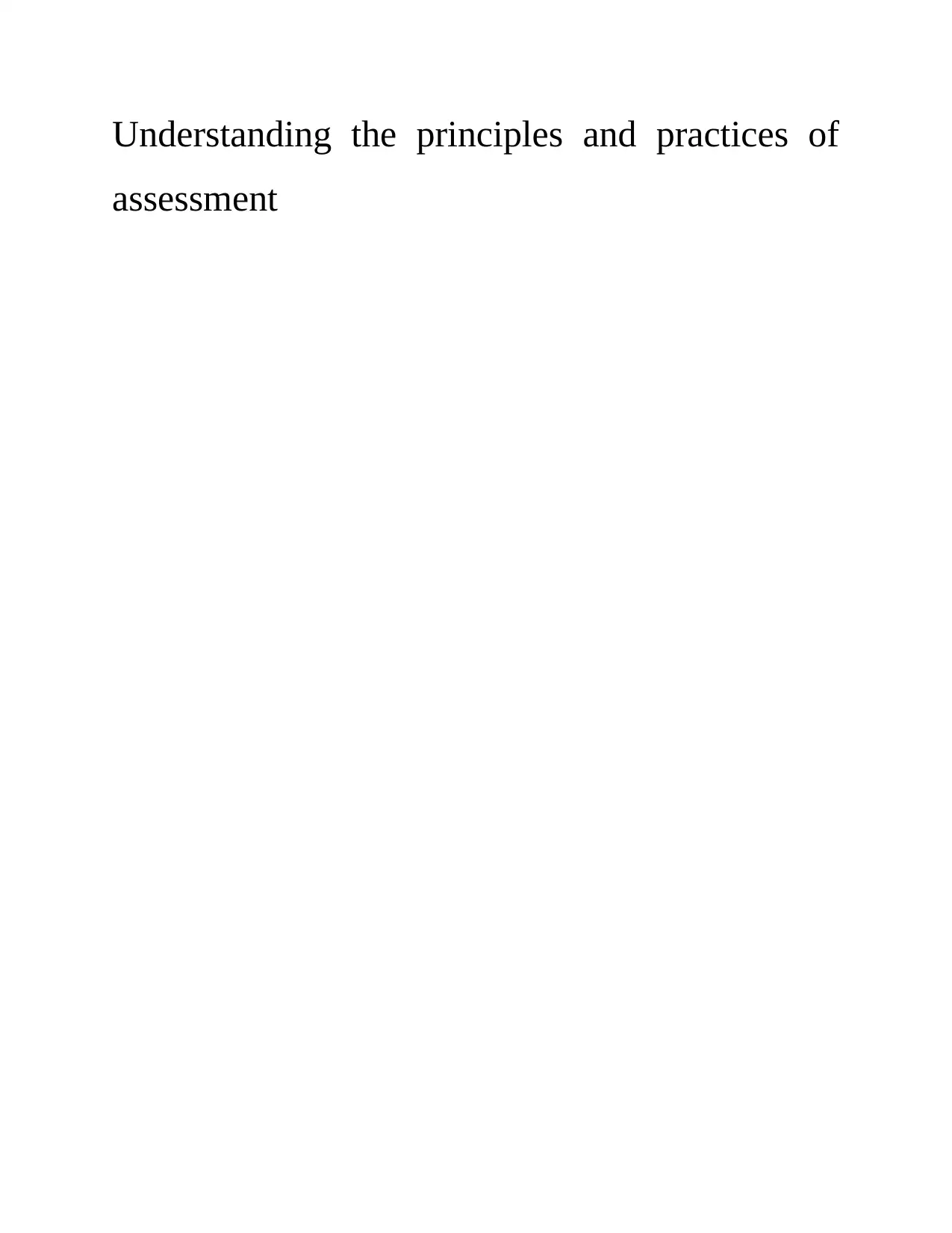
Understanding the principles and practices of
assessment
assessment
Paraphrase This Document
Need a fresh take? Get an instant paraphrase of this document with our AI Paraphraser
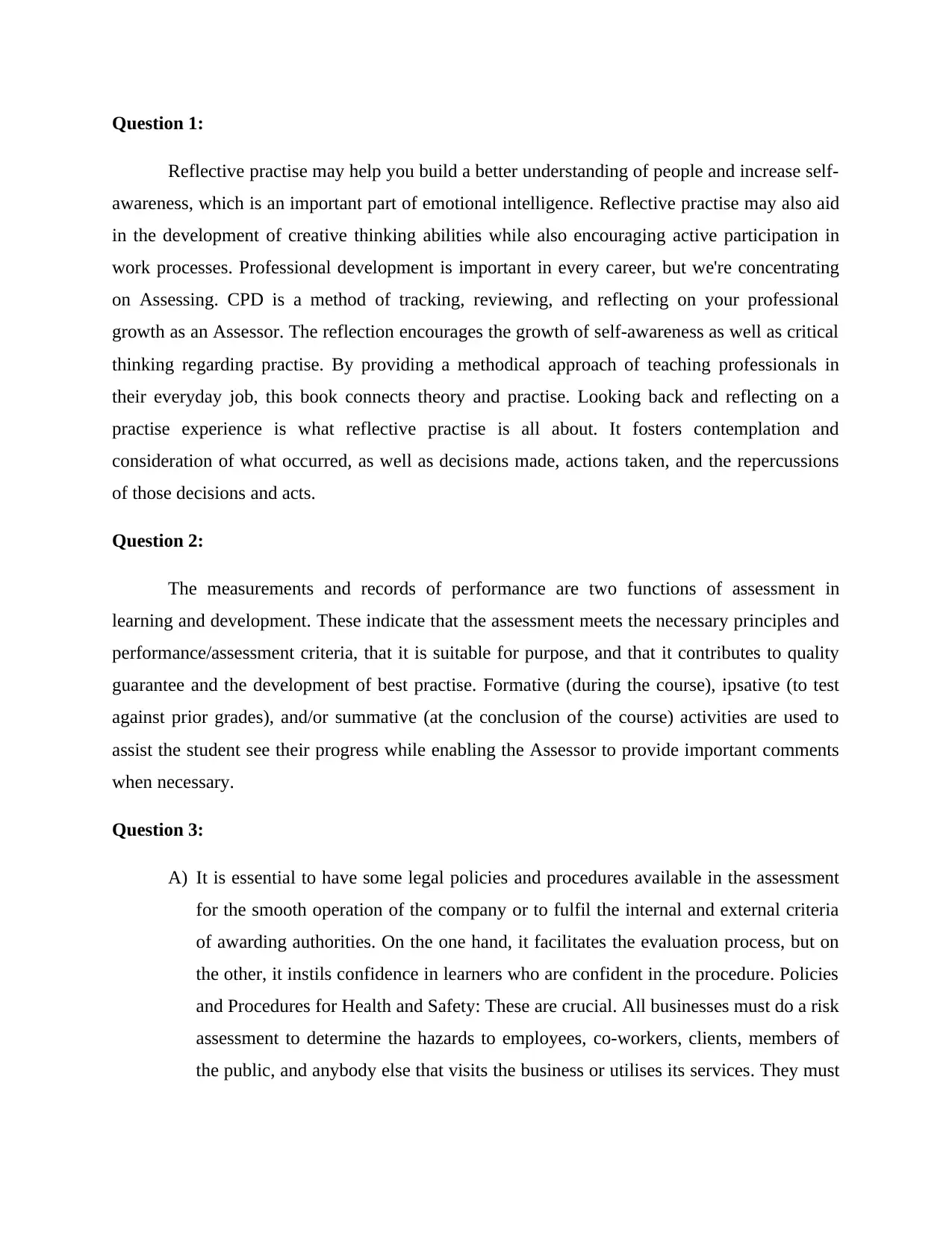
Question 1:
Reflective practise may help you build a better understanding of people and increase self-
awareness, which is an important part of emotional intelligence. Reflective practise may also aid
in the development of creative thinking abilities while also encouraging active participation in
work processes. Professional development is important in every career, but we're concentrating
on Assessing. CPD is a method of tracking, reviewing, and reflecting on your professional
growth as an Assessor. The reflection encourages the growth of self-awareness as well as critical
thinking regarding practise. By providing a methodical approach of teaching professionals in
their everyday job, this book connects theory and practise. Looking back and reflecting on a
practise experience is what reflective practise is all about. It fosters contemplation and
consideration of what occurred, as well as decisions made, actions taken, and the repercussions
of those decisions and acts.
Question 2:
The measurements and records of performance are two functions of assessment in
learning and development. These indicate that the assessment meets the necessary principles and
performance/assessment criteria, that it is suitable for purpose, and that it contributes to quality
guarantee and the development of best practise. Formative (during the course), ipsative (to test
against prior grades), and/or summative (at the conclusion of the course) activities are used to
assist the student see their progress while enabling the Assessor to provide important comments
when necessary.
Question 3:
A) It is essential to have some legal policies and procedures available in the assessment
for the smooth operation of the company or to fulfil the internal and external criteria
of awarding authorities. On the one hand, it facilitates the evaluation process, but on
the other, it instils confidence in learners who are confident in the procedure. Policies
and Procedures for Health and Safety: These are crucial. All businesses must do a risk
assessment to determine the hazards to employees, co-workers, clients, members of
the public, and anybody else that visits the business or utilises its services. They must
Reflective practise may help you build a better understanding of people and increase self-
awareness, which is an important part of emotional intelligence. Reflective practise may also aid
in the development of creative thinking abilities while also encouraging active participation in
work processes. Professional development is important in every career, but we're concentrating
on Assessing. CPD is a method of tracking, reviewing, and reflecting on your professional
growth as an Assessor. The reflection encourages the growth of self-awareness as well as critical
thinking regarding practise. By providing a methodical approach of teaching professionals in
their everyday job, this book connects theory and practise. Looking back and reflecting on a
practise experience is what reflective practise is all about. It fosters contemplation and
consideration of what occurred, as well as decisions made, actions taken, and the repercussions
of those decisions and acts.
Question 2:
The measurements and records of performance are two functions of assessment in
learning and development. These indicate that the assessment meets the necessary principles and
performance/assessment criteria, that it is suitable for purpose, and that it contributes to quality
guarantee and the development of best practise. Formative (during the course), ipsative (to test
against prior grades), and/or summative (at the conclusion of the course) activities are used to
assist the student see their progress while enabling the Assessor to provide important comments
when necessary.
Question 3:
A) It is essential to have some legal policies and procedures available in the assessment
for the smooth operation of the company or to fulfil the internal and external criteria
of awarding authorities. On the one hand, it facilitates the evaluation process, but on
the other, it instils confidence in learners who are confident in the procedure. Policies
and Procedures for Health and Safety: These are crucial. All businesses must do a risk
assessment to determine the hazards to employees, co-workers, clients, members of
the public, and anybody else that visits the business or utilises its services. They must
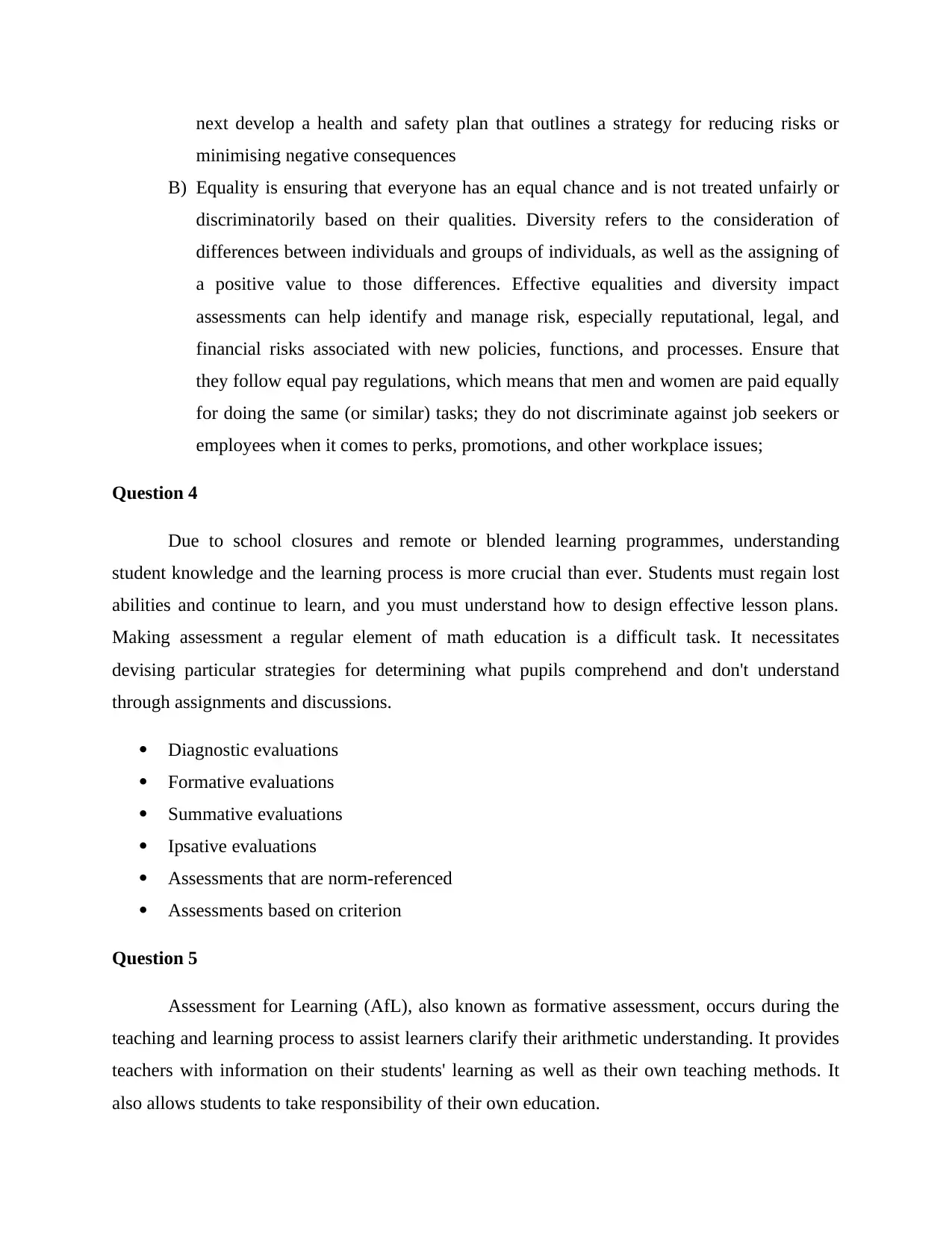
next develop a health and safety plan that outlines a strategy for reducing risks or
minimising negative consequences
B) Equality is ensuring that everyone has an equal chance and is not treated unfairly or
discriminatorily based on their qualities. Diversity refers to the consideration of
differences between individuals and groups of individuals, as well as the assigning of
a positive value to those differences. Effective equalities and diversity impact
assessments can help identify and manage risk, especially reputational, legal, and
financial risks associated with new policies, functions, and processes. Ensure that
they follow equal pay regulations, which means that men and women are paid equally
for doing the same (or similar) tasks; they do not discriminate against job seekers or
employees when it comes to perks, promotions, and other workplace issues;
Question 4
Due to school closures and remote or blended learning programmes, understanding
student knowledge and the learning process is more crucial than ever. Students must regain lost
abilities and continue to learn, and you must understand how to design effective lesson plans.
Making assessment a regular element of math education is a difficult task. It necessitates
devising particular strategies for determining what pupils comprehend and don't understand
through assignments and discussions.
Diagnostic evaluations
Formative evaluations
Summative evaluations
Ipsative evaluations
Assessments that are norm-referenced
Assessments based on criterion
Question 5
Assessment for Learning (AfL), also known as formative assessment, occurs during the
teaching and learning process to assist learners clarify their arithmetic understanding. It provides
teachers with information on their students' learning as well as their own teaching methods. It
also allows students to take responsibility of their own education.
minimising negative consequences
B) Equality is ensuring that everyone has an equal chance and is not treated unfairly or
discriminatorily based on their qualities. Diversity refers to the consideration of
differences between individuals and groups of individuals, as well as the assigning of
a positive value to those differences. Effective equalities and diversity impact
assessments can help identify and manage risk, especially reputational, legal, and
financial risks associated with new policies, functions, and processes. Ensure that
they follow equal pay regulations, which means that men and women are paid equally
for doing the same (or similar) tasks; they do not discriminate against job seekers or
employees when it comes to perks, promotions, and other workplace issues;
Question 4
Due to school closures and remote or blended learning programmes, understanding
student knowledge and the learning process is more crucial than ever. Students must regain lost
abilities and continue to learn, and you must understand how to design effective lesson plans.
Making assessment a regular element of math education is a difficult task. It necessitates
devising particular strategies for determining what pupils comprehend and don't understand
through assignments and discussions.
Diagnostic evaluations
Formative evaluations
Summative evaluations
Ipsative evaluations
Assessments that are norm-referenced
Assessments based on criterion
Question 5
Assessment for Learning (AfL), also known as formative assessment, occurs during the
teaching and learning process to assist learners clarify their arithmetic understanding. It provides
teachers with information on their students' learning as well as their own teaching methods. It
also allows students to take responsibility of their own education.
⊘ This is a preview!⊘
Do you want full access?
Subscribe today to unlock all pages.

Trusted by 1+ million students worldwide
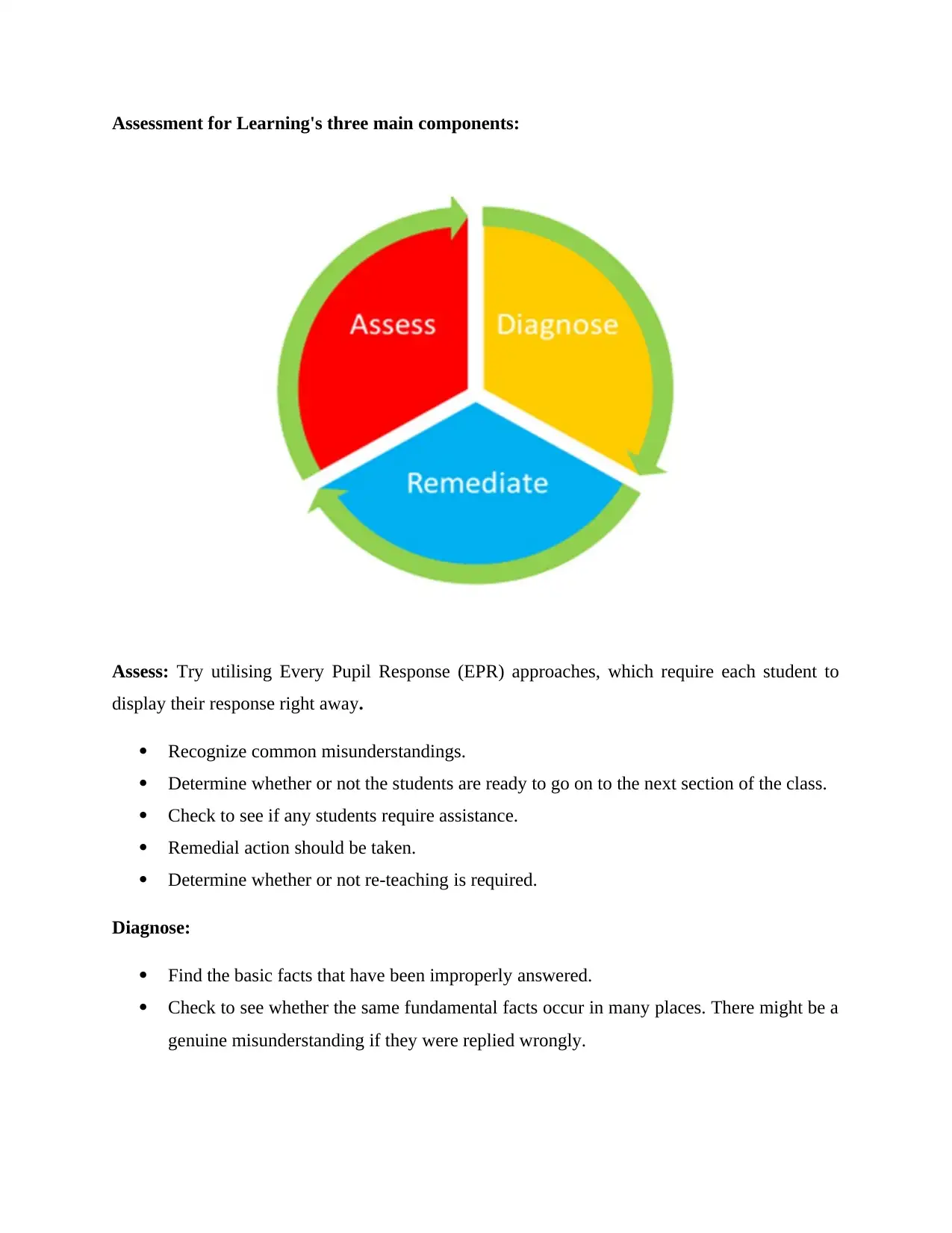
Assessment for Learning's three main components:
Assess: Try utilising Every Pupil Response (EPR) approaches, which require each student to
display their response right away.
Recognize common misunderstandings.
Determine whether or not the students are ready to go on to the next section of the class.
Check to see if any students require assistance.
Remedial action should be taken.
Determine whether or not re-teaching is required.
Diagnose:
Find the basic facts that have been improperly answered.
Check to see whether the same fundamental facts occur in many places. There might be a
genuine misunderstanding if they were replied wrongly.
Assess: Try utilising Every Pupil Response (EPR) approaches, which require each student to
display their response right away.
Recognize common misunderstandings.
Determine whether or not the students are ready to go on to the next section of the class.
Check to see if any students require assistance.
Remedial action should be taken.
Determine whether or not re-teaching is required.
Diagnose:
Find the basic facts that have been improperly answered.
Check to see whether the same fundamental facts occur in many places. There might be a
genuine misunderstanding if they were replied wrongly.
Paraphrase This Document
Need a fresh take? Get an instant paraphrase of this document with our AI Paraphraser
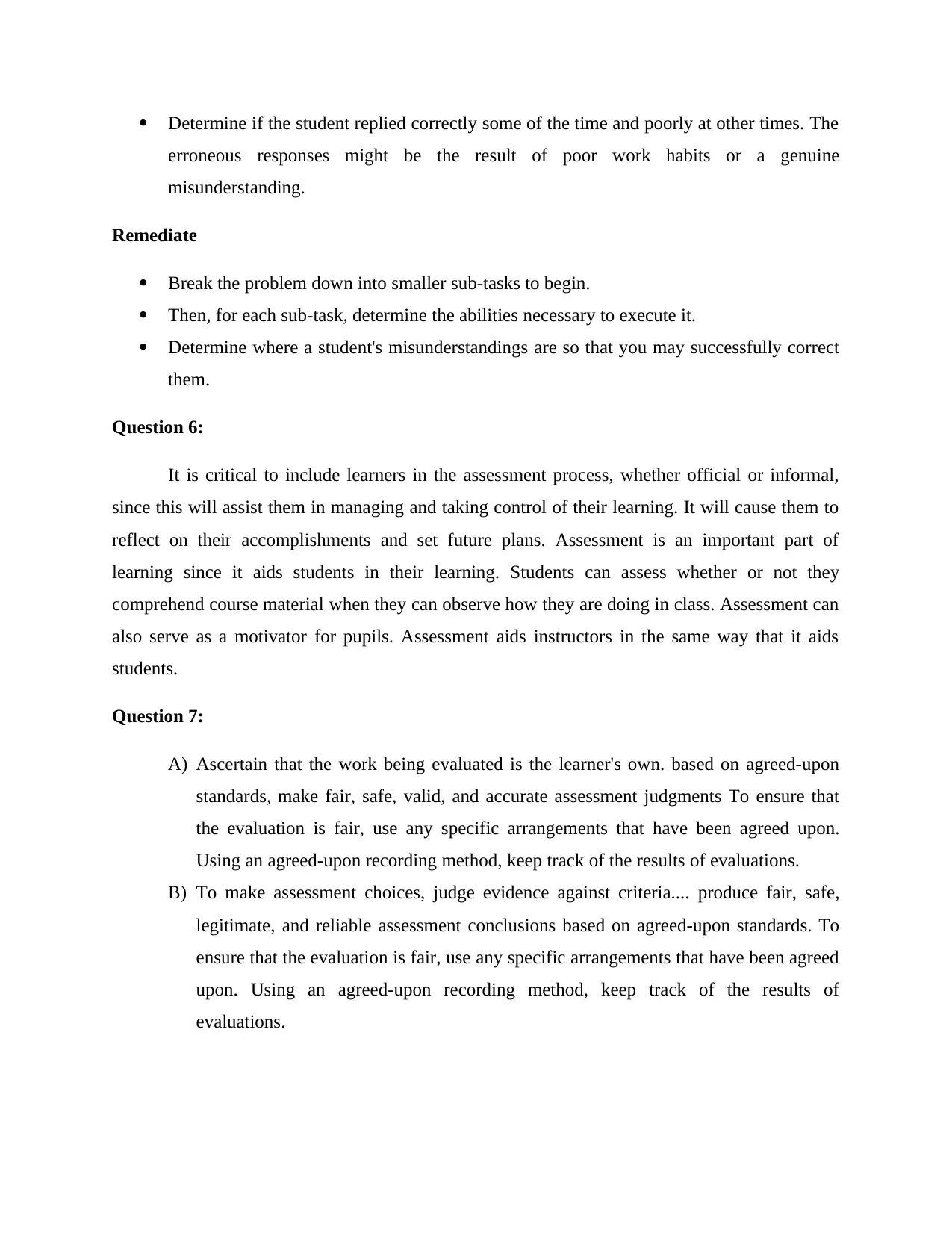
Determine if the student replied correctly some of the time and poorly at other times. The
erroneous responses might be the result of poor work habits or a genuine
misunderstanding.
Remediate
Break the problem down into smaller sub-tasks to begin.
Then, for each sub-task, determine the abilities necessary to execute it.
Determine where a student's misunderstandings are so that you may successfully correct
them.
Question 6:
It is critical to include learners in the assessment process, whether official or informal,
since this will assist them in managing and taking control of their learning. It will cause them to
reflect on their accomplishments and set future plans. Assessment is an important part of
learning since it aids students in their learning. Students can assess whether or not they
comprehend course material when they can observe how they are doing in class. Assessment can
also serve as a motivator for pupils. Assessment aids instructors in the same way that it aids
students.
Question 7:
A) Ascertain that the work being evaluated is the learner's own. based on agreed-upon
standards, make fair, safe, valid, and accurate assessment judgments To ensure that
the evaluation is fair, use any specific arrangements that have been agreed upon.
Using an agreed-upon recording method, keep track of the results of evaluations.
B) To make assessment choices, judge evidence against criteria.... produce fair, safe,
legitimate, and reliable assessment conclusions based on agreed-upon standards. To
ensure that the evaluation is fair, use any specific arrangements that have been agreed
upon. Using an agreed-upon recording method, keep track of the results of
evaluations.
erroneous responses might be the result of poor work habits or a genuine
misunderstanding.
Remediate
Break the problem down into smaller sub-tasks to begin.
Then, for each sub-task, determine the abilities necessary to execute it.
Determine where a student's misunderstandings are so that you may successfully correct
them.
Question 6:
It is critical to include learners in the assessment process, whether official or informal,
since this will assist them in managing and taking control of their learning. It will cause them to
reflect on their accomplishments and set future plans. Assessment is an important part of
learning since it aids students in their learning. Students can assess whether or not they
comprehend course material when they can observe how they are doing in class. Assessment can
also serve as a motivator for pupils. Assessment aids instructors in the same way that it aids
students.
Question 7:
A) Ascertain that the work being evaluated is the learner's own. based on agreed-upon
standards, make fair, safe, valid, and accurate assessment judgments To ensure that
the evaluation is fair, use any specific arrangements that have been agreed upon.
Using an agreed-upon recording method, keep track of the results of evaluations.
B) To make assessment choices, judge evidence against criteria.... produce fair, safe,
legitimate, and reliable assessment conclusions based on agreed-upon standards. To
ensure that the evaluation is fair, use any specific arrangements that have been agreed
upon. Using an agreed-upon recording method, keep track of the results of
evaluations.
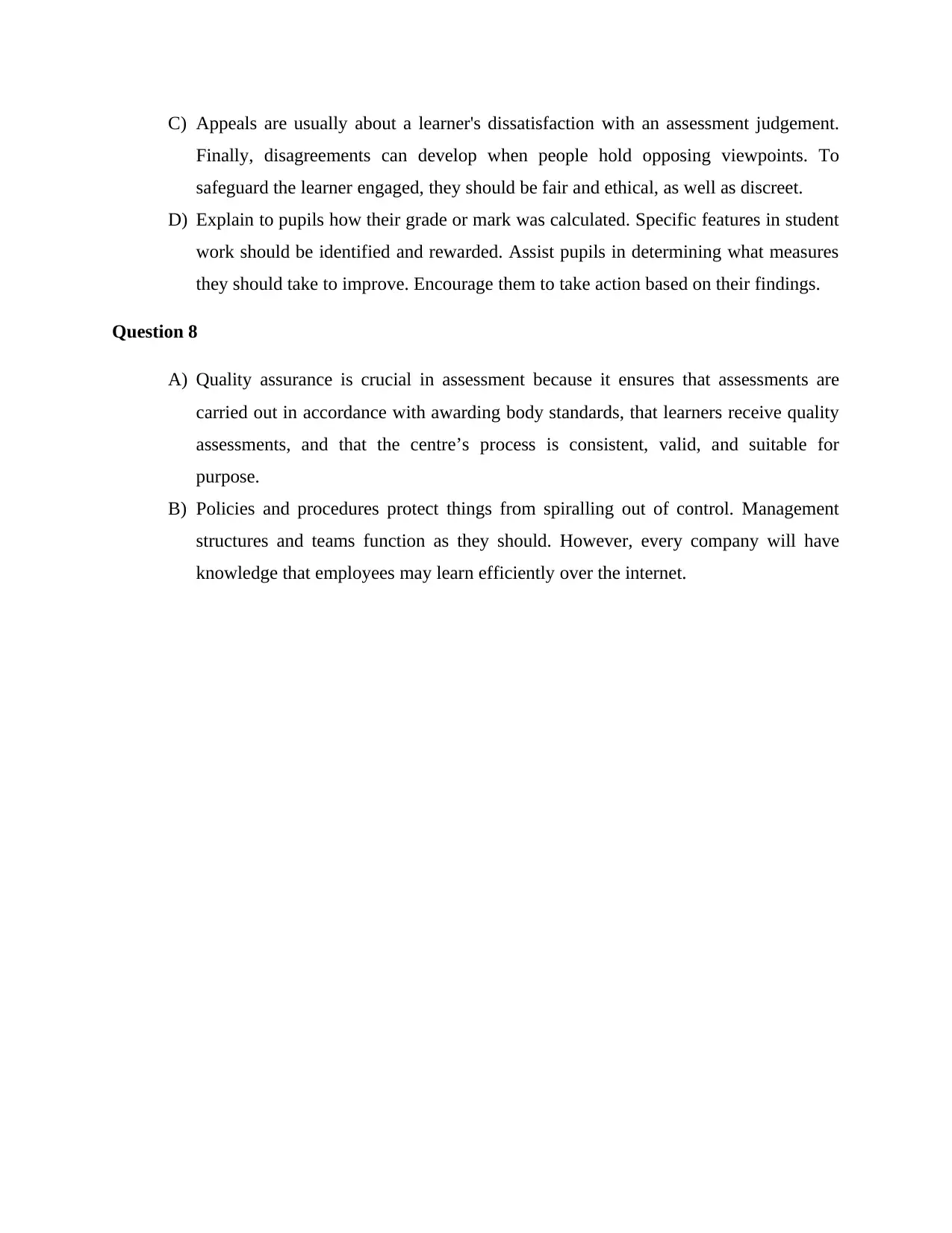
C) Appeals are usually about a learner's dissatisfaction with an assessment judgement.
Finally, disagreements can develop when people hold opposing viewpoints. To
safeguard the learner engaged, they should be fair and ethical, as well as discreet.
D) Explain to pupils how their grade or mark was calculated. Specific features in student
work should be identified and rewarded. Assist pupils in determining what measures
they should take to improve. Encourage them to take action based on their findings.
Question 8
A) Quality assurance is crucial in assessment because it ensures that assessments are
carried out in accordance with awarding body standards, that learners receive quality
assessments, and that the centre’s process is consistent, valid, and suitable for
purpose.
B) Policies and procedures protect things from spiralling out of control. Management
structures and teams function as they should. However, every company will have
knowledge that employees may learn efficiently over the internet.
Finally, disagreements can develop when people hold opposing viewpoints. To
safeguard the learner engaged, they should be fair and ethical, as well as discreet.
D) Explain to pupils how their grade or mark was calculated. Specific features in student
work should be identified and rewarded. Assist pupils in determining what measures
they should take to improve. Encourage them to take action based on their findings.
Question 8
A) Quality assurance is crucial in assessment because it ensures that assessments are
carried out in accordance with awarding body standards, that learners receive quality
assessments, and that the centre’s process is consistent, valid, and suitable for
purpose.
B) Policies and procedures protect things from spiralling out of control. Management
structures and teams function as they should. However, every company will have
knowledge that employees may learn efficiently over the internet.
⊘ This is a preview!⊘
Do you want full access?
Subscribe today to unlock all pages.

Trusted by 1+ million students worldwide
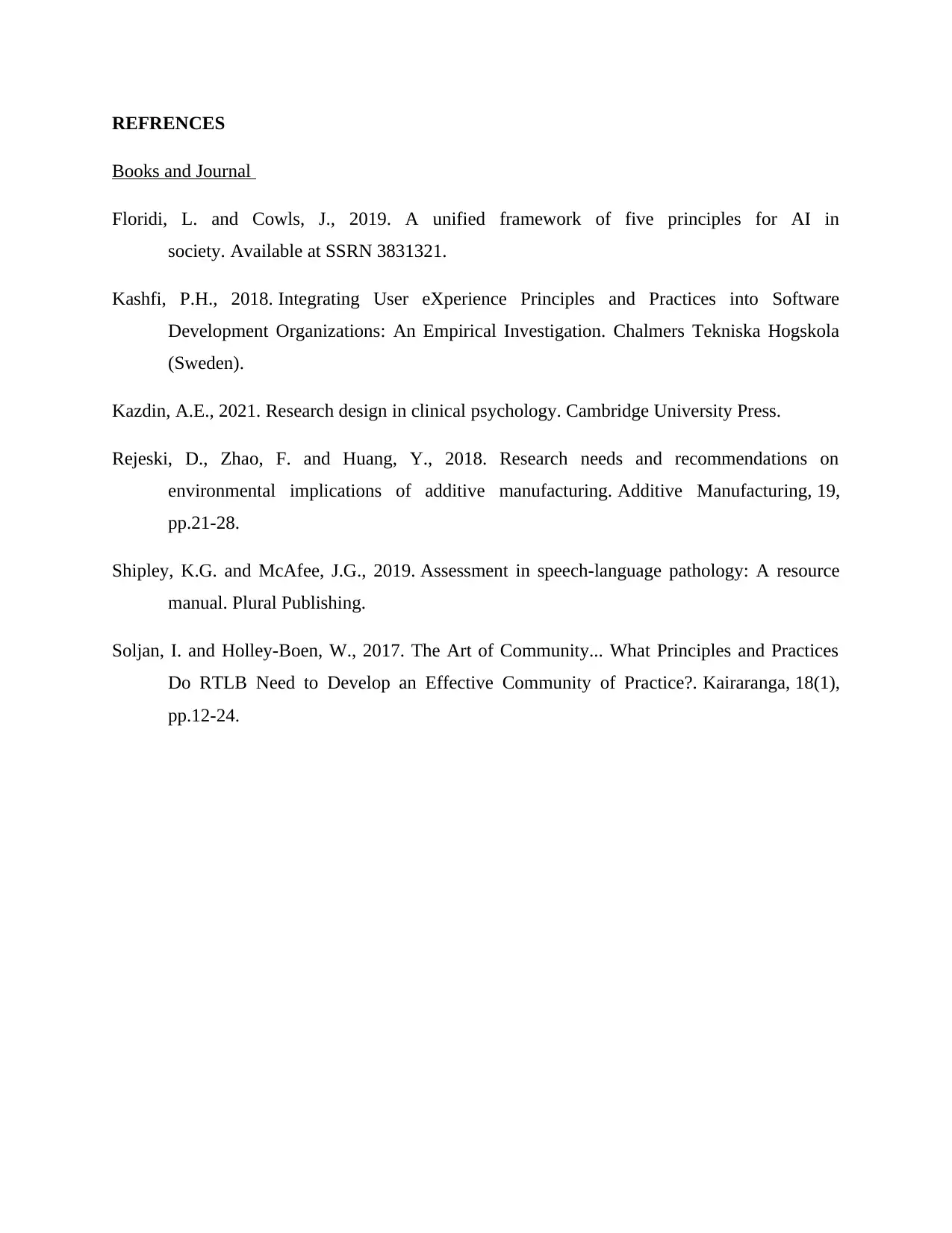
REFRENCES
Books and Journal
Floridi, L. and Cowls, J., 2019. A unified framework of five principles for AI in
society. Available at SSRN 3831321.
Kashfi, P.H., 2018. Integrating User eXperience Principles and Practices into Software
Development Organizations: An Empirical Investigation. Chalmers Tekniska Hogskola
(Sweden).
Kazdin, A.E., 2021. Research design in clinical psychology. Cambridge University Press.
Rejeski, D., Zhao, F. and Huang, Y., 2018. Research needs and recommendations on
environmental implications of additive manufacturing. Additive Manufacturing, 19,
pp.21-28.
Shipley, K.G. and McAfee, J.G., 2019. Assessment in speech-language pathology: A resource
manual. Plural Publishing.
Soljan, I. and Holley-Boen, W., 2017. The Art of Community... What Principles and Practices
Do RTLB Need to Develop an Effective Community of Practice?. Kairaranga, 18(1),
pp.12-24.
Books and Journal
Floridi, L. and Cowls, J., 2019. A unified framework of five principles for AI in
society. Available at SSRN 3831321.
Kashfi, P.H., 2018. Integrating User eXperience Principles and Practices into Software
Development Organizations: An Empirical Investigation. Chalmers Tekniska Hogskola
(Sweden).
Kazdin, A.E., 2021. Research design in clinical psychology. Cambridge University Press.
Rejeski, D., Zhao, F. and Huang, Y., 2018. Research needs and recommendations on
environmental implications of additive manufacturing. Additive Manufacturing, 19,
pp.21-28.
Shipley, K.G. and McAfee, J.G., 2019. Assessment in speech-language pathology: A resource
manual. Plural Publishing.
Soljan, I. and Holley-Boen, W., 2017. The Art of Community... What Principles and Practices
Do RTLB Need to Develop an Effective Community of Practice?. Kairaranga, 18(1),
pp.12-24.
1 out of 7
Related Documents
Your All-in-One AI-Powered Toolkit for Academic Success.
+13062052269
info@desklib.com
Available 24*7 on WhatsApp / Email
![[object Object]](/_next/static/media/star-bottom.7253800d.svg)
Unlock your academic potential
Copyright © 2020–2025 A2Z Services. All Rights Reserved. Developed and managed by ZUCOL.





